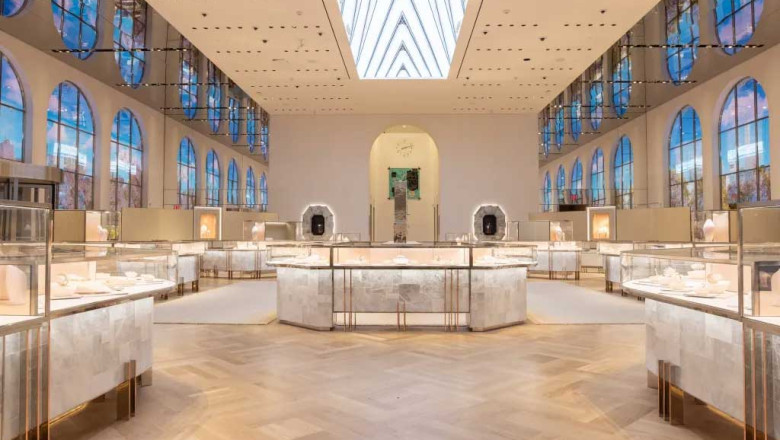
views
Global Luxury Goods Market Seen Growing to 1.5 Trillion Euros in 2023
MILAN — “We don’t like the term quiet luxury, there is nothing quiet in luxury,” said Claudia D’Arpizio, senior partner at Bain & Company, on Tuesday, presenting the most recent Altagamma and Bain study in Milan.
“Luxury must always reinvent itself, with innovation at the center of it,” she said, underscoring the importance of creativity and a “rebellious spirit,” as well as the importance of investing in technology, talent and sustainability.
The personal luxury goods market is expected to record 4 percent growth by the end of 2023, swelling to an estimated 362 billion euros, according to the Altagamma-Bain & Company Worldwide Luxury Market Monitor 2023. A spring update back in June had projected growth of between 5 and 12 percent in 2023, or between 360 billion and 380 billion euros. The study expects the sector to grow to between 365 billion and 390 billion euros in 2024.
The global luxury market is forecasting gains of between 8 and 10 percent in 2023 compared with 2022, reaching sales of 1.5 trillion euros, which is a new record and proves its resilience, said Federica Levato, senior partner & Bain & Company and coauthor with D’Arpizio of the study, called “Long Live Luxury.”
At constant exchange rates, the industry is projecting growth of between 11 and 13 percent, in line with last year.
“The good news is that the luxury market continues to grow, all categories recovered to pre-COVID-19 levels, and the reopening of China allowed [the industry] to take a leap forward,” Levato said.
Levato noted that macroeconomic and geographic uncertainties “substantially reverberated on luxury consumer spending, and especially the last quarter is showing a slowdown, affected by China’s economic tensions, the Israel conflict with Gaza, the consolidation in the U.S. and in Europe, and the increase in interest rates and the high inflation, even though these are seen in progressive normalization.”
The headwinds are not stopping medium-term growth, as Bain expects a mid-single-digit gain until 2030, leveraging “super solid fundamentals.”
Europe benefited from a recovery in tourism as well as local spending, although a slight slowdown is reported in the last quarter. Americans and Asians, in particular visitors from Thailand, as well as Chinese were cited as strong clusters of shoppers. Now Chinese spending amounts to 40 percent of what it was in 2019, “which is a great result,” said Levato, considering the pandemic.
U.S. spending registered a deceleration in the year, with an 8 percent contraction versus 2022.
Higher growth was expected in China, but Chinese tourists helped drive sales in Japan. “The country is the number one in terms of growth, driven also by local spending and a weak yen, which boosts tourism,” said Levato, who also singled out Hong Kong and Macao, as well as South East Asia, as showing growth.
Generally, there has been “an elevation” of the market, with a contraction in volumes because of higher average retail prices of products, Levato said.
All categories are growing, with a shift toward investment pieces. Sales of apparel of a more elevated quality are growing, as is the jewelry category.
By 2030, Gen Z will account for between 25 and 30 percent of luxury goods purchases while Millennials will account for between 50 and 55 percent.
Bain expects more M&A deals driven by the need to tackle such challenges as sustainability and digitalization. “This is a pivotal moment for the market and the winners will differentiate themselves for resilience, relevance and renovation, daring to take bold decisions,” said D’Arpizio, noting that the luxury market is generating a positive growth for around 65 or 70 percent of brands in 2023, compared with 95 percent in 2022.
Stefania Lazzaroni, general director of Altagamma, presented the foundation’s Consensus study, which estimates earnings before interest, taxes, depreciation and amortization of luxury companies to stand at around 4 percent in 2024, following the need for companies last year to increase retail prices to compensate for higher costs. Sales are expected to grow from 5 to 6 percent. As per the Consensus, Europe next year is expected to grow 4 percent; in its election year, the U.S. is seen growing 2.5 percent; Latin America 3 percent, and Japan 6 percent. China is forecast to grow 8 percent and the Middle East by 7 percent.
In terms of categories, leather goods are seen growing 6.5 percent and shoes by 5 percent. Beauty is expected to grow 5 percent; apparel by 4 percent, and jewelry by 5.5. percent. Watches are expected to gain 3.5 percent.
Matteo Lunelli, chairman of Altagamma, said he hoped the Italian government will further support Italian production and the country’s pipeline, also at the European level, and urged European countries to be more compact in order to tackle the “increasingly more complex challenges,” and continue to invest in digitalization, training and sustainability.
Renzo Rosso, founder of OTB, said he expected double-digit growth for the company, hoping for currency tailwinds after the group was dented by headwinds connected to the yen in Japan, which is a key market for the group, accounting for 24 percent of sales. He singled out South Korea as perhaps the best-performing market in Asia, which is growing well, while also citing China, Vietnam and Thailand.
OTB comprises the Diesel, Maison Margiela, Marni, Jil Sander and Viktor & Rolf brands and it has a minority stake in Amiri. “We have been shifting toward luxury as this is a segment that is never in a crisis and allows investments in sustainability,” Rosso said. “Gen Z, which already represent 35 percent of our customers, want sustainability.”
Rosso spoke of the CASH project promoted by OTB, which supports the supply chain of small and medium-sized companies in the country, of the need to protect Italian craftsmanship, and of the potential of AI, which he views as a “fantastic” tool, which, he contended, will help improve our lifestyle and health and create new and different jobs. The relationship with customers can only improve through the use of AI, he believes.
Angelo Zegna, consumer and retail excellence director at the Ermenegildo Zegna Group, also underscored the importance of clienteling and said that “technology makes no sense if it does not make the consumer’s life easier.” To this end and for personalized experiences, as well as Su Misura styles, he said the company has created an app to contact its clients and launched Zegna X, which offers its customers 49 combinations of looks.
After the arrival of private equity firm Permira, which acquired a majority stake in Gruppo Florence last May, the Italian group is eyeing an initial public offer, CEO Attila Kiss reiterated on stage.
Gruppo Florence was established in October 2020 with the goal of developing a platform to supply high-quality Made in Italy products to major luxury fashion brands, while safeguarding the technical and cultural know-how of small and medium-sized family-owned Italian companies.
The group has quickly grown to own 30 companies and, as is customary for Gruppo Florence, the founding families have agreed to reinvest in the holding as minority shareholders.
The group generated revenues of more than 600 million euros in 2022.
Alexandre Boquel, director of Métiers d’Excellence LVMH, said the international conglomerate has 22 internal schools for 75 brands and 300 training programs, underscoring the importance of enhancing the role of artisans.
Pier Francesco Nervini, chief operating officer for North and Central Europe and global accounts at Global Blue, said that, in Continental Europe, tax-free spending on luxury products is higher than in 2019, registering since the beginning of the year a rise of around 15 percent compared with 2019. This was driven by Americans and by tourists from the Gulf countries, who increased their spending by 250 and 170 percent, respectively, in the first 10 months of the year compared with 2019.
Chinese tourists are beginning to return to Europe and that the profile of this consumer is generally younger, eyeing fashion and clothing and most likely to spend more on luxury, said Nervini, seeing the gradual recovery of tourists from China as promising.




















Comments
0 comment